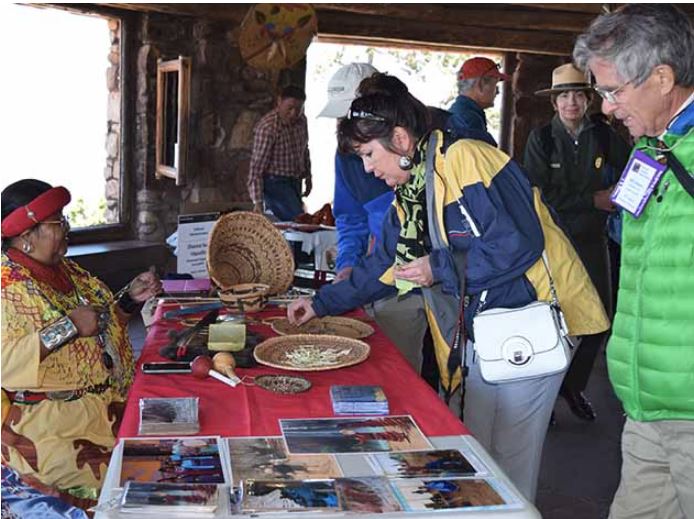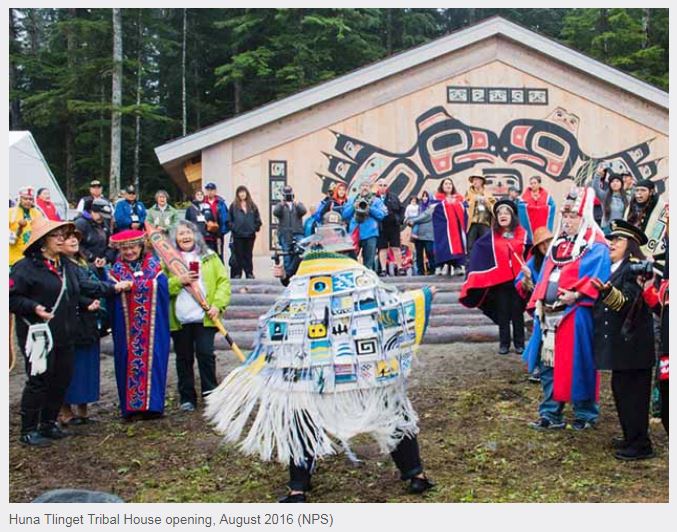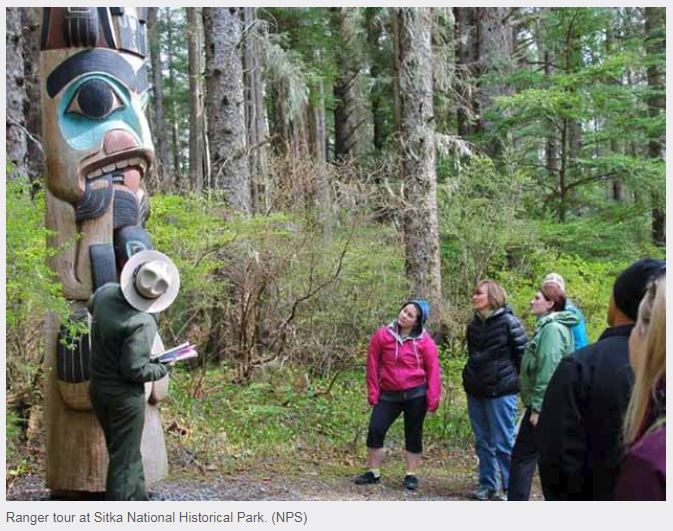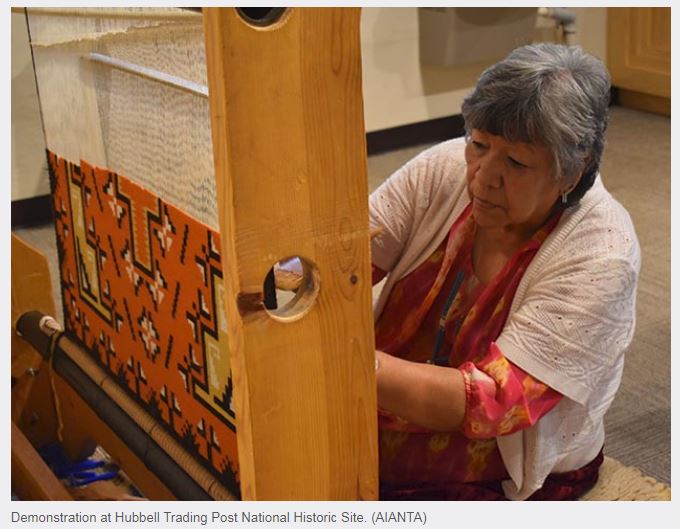Recreation.gov: Experience Native American Culture across the U.S.
In honor of American Indian and Alaska Native Heritage Month, AIANTA partnered with the team at Recreation.gov to pull together some examples of Public Lands around the nation working with the tribes in their area or affiliated with their landscape.
Read the full, collaborative story right here, encouraging travelers to experience Native American culture across the United States:
 See the original article at Recreation.gov
See the original article at Recreation.gov
November is National Native American Heritage Month – a time designated for celebrating the rich and diverse cultures, traditions and histories of America’s Native peoples. The American Indian Alaska Native Tourism Association (AIANTA) views this month as an opportune time for education, awareness and acknowledgment of the important contributions of Native peoples to the U.S.
AIANTA encourages all to learn these histories and cultures through travel. The true histories of America’s First peoples are best told from their own voices and perspectives.
In recent years, new efforts have been made in many parks and other public lands to incorporate tribal voices into the visitor experience and cultural interpretation. A number of park-tribal collaborations and other partnerships between public lands and tribal communities have been created, offering tribes new opportunities for cultural expression and giving park visitors new perspectives on history, community and the land.
Cultural experiences at National Parks and along Route 66
Glacier Bay National Park and Preserve, Alaska
 Twenty years of relationship building and collaboration between the Hoonah Indian Association (the federally-recognized tribal government of the Huna Tlingit) and Glacier Bay National Park and Preserve was celebrated at the opening of the Huna Tlingit Tribal House (Xunaa Shuká Hít)on August 25, 2016. The Tribal House provides a venue for ceremonies, workshops, camps and tribal meetings. Through mentoring, apprentice opportunities and interpretive programming, the Huna Tlingit Tribal House ensures that Huna Tlingit culture, language and history will be passed on to current and future generations.
Twenty years of relationship building and collaboration between the Hoonah Indian Association (the federally-recognized tribal government of the Huna Tlingit) and Glacier Bay National Park and Preserve was celebrated at the opening of the Huna Tlingit Tribal House (Xunaa Shuká Hít)on August 25, 2016. The Tribal House provides a venue for ceremonies, workshops, camps and tribal meetings. Through mentoring, apprentice opportunities and interpretive programming, the Huna Tlingit Tribal House ensures that Huna Tlingit culture, language and history will be passed on to current and future generations.
Sitka National Historical Park, Alaska
 Established as a National Monument in 1910, Sitka National Historical Park commemorates Russian settlement in Alaska and interprets the decisive Battle of 1804, when Russian forces drove the indigenous Tlingit from their land. The park protects Native totems and offers visitors the opportunity to watch Native artists as they work.
Established as a National Monument in 1910, Sitka National Historical Park commemorates Russian settlement in Alaska and interprets the decisive Battle of 1804, when Russian forces drove the indigenous Tlingit from their land. The park protects Native totems and offers visitors the opportunity to watch Native artists as they work.
The Alaska Natives Tribes in Sitka faced extreme challenges for hundreds of years, and today under a mutual understanding the park shares the story of the conflict between Europeans and Alaska Natives, including the native perspective. Telling the greater story of a blending of cultures that shaped and continues to influence Alaska’s history and heritage, the Sitka National Historical Park gives visitors insight into the area’s history and rich living culture. At the visitor center and nearby Southeast Alaska Indian Cultural Center, visitors can learn not only about the past but also about the future as Native artists demonstrate mastery of their crafts.
Desert View Watchtower, Grand Canyon National Park, Arizona
 At the Desert View Area and Watchtower in Grand Canyon National Park, the expertise and voices of the park’s inter-tribal advisory council and park staff along with support from AIANTA are launching a new vision and model for interpretation and tribal engagement. Park visitors can now engage with first-voice cultural demonstrators and interpreters while tribal youth can take part in internship and employment opportunities offered by the park. Over time, an inter-tribal heritage center will be developed where visitors can learn more about neighboring tribes and get information for visiting tribal reservations.
At the Desert View Area and Watchtower in Grand Canyon National Park, the expertise and voices of the park’s inter-tribal advisory council and park staff along with support from AIANTA are launching a new vision and model for interpretation and tribal engagement. Park visitors can now engage with first-voice cultural demonstrators and interpreters while tribal youth can take part in internship and employment opportunities offered by the park. Over time, an inter-tribal heritage center will be developed where visitors can learn more about neighboring tribes and get information for visiting tribal reservations.
Hubbell Trading Post National Historic Site
 For a piece of unique history plus authentic Native American artwork and gifts, make a stop at the Hubbell Trading Post in Arizona – the oldest operating trading post on the Navajo Nation. John Lorenzo Hubbell purchased the trading post in 1878, ten years after Navajos were allowed to return to their homeland from their terrible exile at Bosque Redondo, Ft. Sumner, New Mexico. During the four years spent at Bosque Redondo, Navajos were introduced to many new household and farming items. Traders like Hubbell supplied those items once the Navajo returned home.
For a piece of unique history plus authentic Native American artwork and gifts, make a stop at the Hubbell Trading Post in Arizona – the oldest operating trading post on the Navajo Nation. John Lorenzo Hubbell purchased the trading post in 1878, ten years after Navajos were allowed to return to their homeland from their terrible exile at Bosque Redondo, Ft. Sumner, New Mexico. During the four years spent at Bosque Redondo, Navajos were introduced to many new household and farming items. Traders like Hubbell supplied those items once the Navajo returned home.
Today, the trading post offers a wide selection of Navajo rugs and other craft work educational workshops, and live Navajo weaving demonstrations.
Interested visitors can also explore selected artwork by Elbridge Ayer Burbank from the Hubbell Trading Post National Historic Site museum collection. They were featured in the Portraits of the People: E.A. Burbank at Hubbell Trading Post exhibit at the Navajo Nation Museum, Window Rock, Arizona in 2002. Many of the artworks can be seen at Hubbell Trading Post National Historic Site.
Sand Creek Massacre National Historic Site, Colorado
 Native Heritage Month is an opportunity to learn about and reflect on the difficult history and stories of America’s Native Peoples. While many parks and historical sites offer insight into the challenges and conflicts Native Americans faced throughout history, the Sand Creek Massacre National Historic Site commemorates an especially poignant tragedy through a unique interpretive program. The site offers interpretive tours from trained rangers and offers a deep insight into an atrocity from our nation’s history, while also interpreting a high plains landscape of beautiful bluffs.
Native Heritage Month is an opportunity to learn about and reflect on the difficult history and stories of America’s Native Peoples. While many parks and historical sites offer insight into the challenges and conflicts Native Americans faced throughout history, the Sand Creek Massacre National Historic Site commemorates an especially poignant tragedy through a unique interpretive program. The site offers interpretive tours from trained rangers and offers a deep insight into an atrocity from our nation’s history, while also interpreting a high plains landscape of beautiful bluffs.
Acadia National Park, Maine
Native American peoples have ties to Maine and what is now considered Acadia National Parkthat date back 12,000 years. Currently, there are four distinct tribes that are collectively known as the Wabanaki, or “People of the Dawnland,” that remain connected to this landscape. Today, each tribe has a reservation and government headquarters located within their territories throughout Maine. Still, Wabanaki people have a unique and spiritual relationship with this land, from the first rays of dawn seen from Cadillac Mountain to the last light of dusk slipping behind Bar Island. Many Wabanaki people today come for much the same reasons as others—to hike the mountain trails and enjoy the striking scenery. Yet some still come to gather precious sweetgrass, sell handmade baskets, and to show respect for this sacred landscape, as their ancestors did for thousands of years.
Crater Lake National Park, Oregon
 Crater Lake National Park is a sacred site to the Klamath Tribes. What is now the park was part of their homeland. Their ancestors are said to have witnessed the volcanic eruption that created the lake. The lake remains a place of power, where spirits reside. The lake continues to be a destination for vision quests. Several wayside signs along the lakeshore interpret the significance to the public.
Crater Lake National Park is a sacred site to the Klamath Tribes. What is now the park was part of their homeland. Their ancestors are said to have witnessed the volcanic eruption that created the lake. The lake remains a place of power, where spirits reside. The lake continues to be a destination for vision quests. Several wayside signs along the lakeshore interpret the significance to the public.
American Indians and Route 66, Illinois to California
 The Native American experience along Route 66 is highlighted in a new website and travel guide, created in partnership with AIANTA and the National Park Service. While the guide includes native history and points of interest along the route, it also informs travelers about genuine cultural experiences available today. Compiled with assistance from many tribes along the route, “American Indians and Route 66” gives travelers a more complete picture of the famed journey. Visit www.AmericanIndiansAndRoute66.com for the full guidebook.
The Native American experience along Route 66 is highlighted in a new website and travel guide, created in partnership with AIANTA and the National Park Service. While the guide includes native history and points of interest along the route, it also informs travelers about genuine cultural experiences available today. Compiled with assistance from many tribes along the route, “American Indians and Route 66” gives travelers a more complete picture of the famed journey. Visit www.AmericanIndiansAndRoute66.com for the full guidebook.